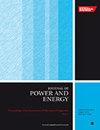Effect of parasitic losses on the design optimization of inward flow radial supercritical CO2 turbines
IF 1.1
4区 工程技术
Q3 ENGINEERING, MECHANICAL
Proceedings of the Institution of Mechanical Engineers, Part A: Journal of Power and Energy
Pub Date : 2023-12-13
DOI:10.1177/09576509231221007
引用次数: 0
Abstract
Inward flow radial (IFR) supercritical CO2 (sCO2) turbines are smaller in size and operate at considerably higher speeds in comparison to similar capacity conventional gas or steam turbines. The compact size and high speed of IFR turbines result in significant parasitic (leakage and disk friction) losses at the rotor backface. This paper presents CFD investigations to understand the mechanism of parasitic losses of IFR turbines in the kW to MW power scales. The first part of the paper presents a parametric study to quantify the effect of backface flowpath dimensions, rotor inlet radius, and rotational speed on the magnitude of parasitic losses. Subsequently, the paper proposes the implementation of a radial labyrinth seal on the rotor backface to curtail the parasitic losses. The second part of the paper examines how the power scale of the turbine and its design parameters, specific speed and velocity ratio, influence the magnitude of parasitic losses. The investigation reveals that parasitic losses cause an efficiency drop of 8%–15% for 100 kW and 4%–9% for 1 MW IFR sCO2 turbines. In addition, IFR turbines designed for low specific speeds and high velocity ratios result in notably higher parasitic losses, leading to a decline in turbine efficiency. Finally, the paper presents optimal turbine design parameters accounting for the parasitic losses to maximize turbine efficiency.寄生损耗对内流径向超临界二氧化碳涡轮机设计优化的影响
与类似容量的传统燃气轮机或蒸汽轮机相比,内流径向(IFR)超临界二氧化碳(sCO2)涡轮机体积更小,运行速度更高。IFR 涡轮机的紧凑尺寸和高速运转会导致转子后表面产生大量寄生(泄漏和盘摩擦)损失。本文介绍了 CFD 研究,以了解千瓦到兆瓦功率级的 IFR 涡轮机寄生损失的机理。论文的第一部分介绍了一项参数研究,以量化后表面流道尺寸、转子进口半径和转速对寄生损耗大小的影响。随后,论文提出了在转子后表面实施径向迷宫密封以减少寄生损耗的建议。论文的第二部分研究了涡轮机的功率等级及其设计参数(比转速和速比)如何影响寄生损耗的大小。调查显示,寄生损耗会导致 100 kW 的 IFR sCO2 涡轮机效率下降 8%-15%,1 MW 的 IFR sCO2 涡轮机效率下降 4%-9%。此外,为低比转速和高流速比设计的 IFR 涡轮机会导致更高的寄生损失,从而导致涡轮机效率下降。最后,本文提出了考虑寄生损失的最佳涡轮机设计参数,以最大限度地提高涡轮机效率。
本文章由计算机程序翻译,如有差异,请以英文原文为准。
求助全文
约1分钟内获得全文
求助全文
来源期刊

CiteScore
3.30
自引率
5.90%
发文量
114
审稿时长
5.4 months
期刊介绍:
The Journal of Power and Energy, Part A of the Proceedings of the Institution of Mechanical Engineers, is dedicated to publishing peer-reviewed papers of high scientific quality on all aspects of the technology of energy conversion systems.
 求助内容:
求助内容: 应助结果提醒方式:
应助结果提醒方式:


